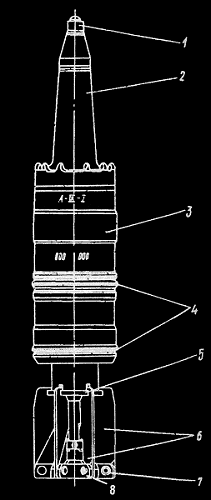125MM HEAT-FS AMMUNITION
Overview
It is not a common knowledge, and is somewhat unexpected for an APFSDS-centered
anti-armor school of thought of today, but originally HEAT-FS rounds were the principal 125mm anti-armor ammunition. In fact, the original 125mm 2A26 (D-81) gun was accepted for T-64A MBT as a result of an emergency uparming procedure, exactly
thanks to its greater HEAT potential. Indeed, original 125mm HEAT rounds outperformed
their APFSDS counterparts by nearly 25%, penetrating over 400mm RHA and ensuring defeat
of all contemporary MBTs at any point of impact. APFSDS rounds, on the contrary, were few
in the Soviet tanks layout, and were only intended for short-range engagements. Even now HEAT rounds account for 45% of standard tank loadout.
HEAT-FS rounds were also substantially more accurate than APFSDS (which might also be
surprising to a Western reader). This is reflected in the Soviet deviation criterion, which
was more strict for HEAT rounds (0.21 mil) than for APFSDS rounds (0.25 mil). However, in
practice HEAT-FS rounds were even more accurate. As control trials of a random
mass-production T-64A held in the 70s (the details of which were made available to
the author) indicated, while APFSDS rounds hugged the outer bounds of acceptance
criterion, HEAT-FS rounds actually demonstrated the average deviation of well under
0.1 mil!
The advent of advanced armor arrays decreased the effectiveness of HEAT ammunition, and
the advance of APFSDS technology and their flatter trajectory and shorter time to target
have relegated HEAT ammunition to the secondary role in tanks loadout. However, in latest
years, HEAT penetrating potential was boosted by ingenious tandem warhead designs, as well
as introduction of unconventional metal liners (DU, tantalum, etc.), that, theoretically,
substantially degrade the performance of advanced armor arrays, in addition to having
improved behind-armor effects.
Layout
 Soviet 125mm HEAT rounds have the following layout: the shaped charge is located in the
cylindrical main body (3) with two driving bands (4). In front of a projectile is an
extended probe (2) to ensure the proper detonation stand-off (on latest models it also
contains the precursor charge that strips off ERA or conditions advanced armor arrays).
The detonator (1) is located on the tip of the probe. In the rear of the projectile are
six folded fins (6) that are attached to the base (8) and are held together by a plastic
ring (5). The later breaks apart upon exit and releases the fins, which unsnap along the
axes (7) and provide stabilisation in flight.
Soviet 125mm HEAT rounds have the following layout: the shaped charge is located in the
cylindrical main body (3) with two driving bands (4). In front of a projectile is an
extended probe (2) to ensure the proper detonation stand-off (on latest models it also
contains the precursor charge that strips off ERA or conditions advanced armor arrays).
The detonator (1) is located on the tip of the probe. In the rear of the projectile are
six folded fins (6) that are attached to the base (8) and are held together by a plastic
ring (5). The later breaks apart upon exit and releases the fins, which unsnap along the
axes (7) and provide stabilisation in flight.
The HEAT rounds utilise the standard propelling charge (4Zh40 or 4Zh52) and have the muzzle velocity around 905 m/s, which makes it problematic to engage moving targets with them.

This page is © 2001-2007 Vasiliy Fofanov
 Soviet 125mm HEAT rounds have the following layout: the shaped charge is located in the
cylindrical main body (3) with two driving bands (4). In front of a projectile is an
extended probe (2) to ensure the proper detonation stand-off (on latest models it also
contains the precursor charge that strips off ERA or conditions advanced armor arrays).
The detonator (1) is located on the tip of the probe. In the rear of the projectile are
six folded fins (6) that are attached to the base (8) and are held together by a plastic
ring (5). The later breaks apart upon exit and releases the fins, which unsnap along the
axes (7) and provide stabilisation in flight.
Soviet 125mm HEAT rounds have the following layout: the shaped charge is located in the
cylindrical main body (3) with two driving bands (4). In front of a projectile is an
extended probe (2) to ensure the proper detonation stand-off (on latest models it also
contains the precursor charge that strips off ERA or conditions advanced armor arrays).
The detonator (1) is located on the tip of the probe. In the rear of the projectile are
six folded fins (6) that are attached to the base (8) and are held together by a plastic
ring (5). The later breaks apart upon exit and releases the fins, which unsnap along the
axes (7) and provide stabilisation in flight.
